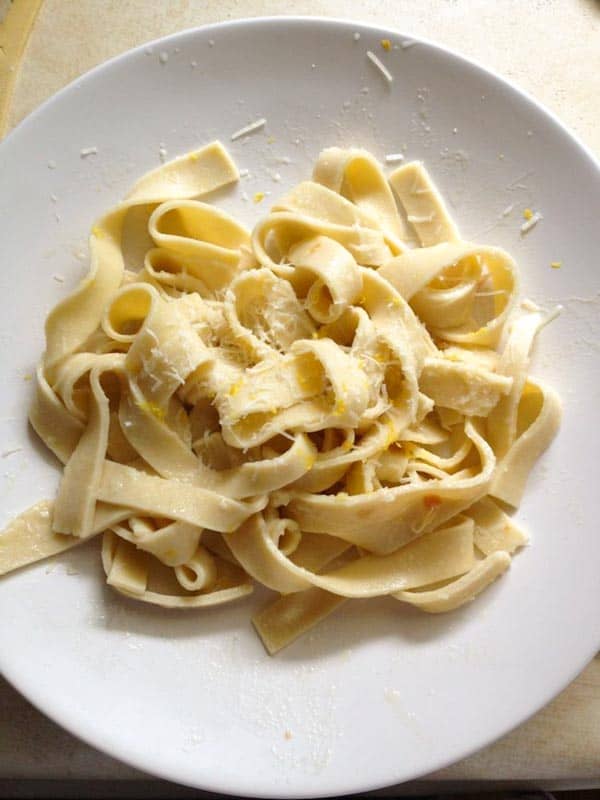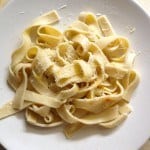
Recently, I had one of those days when everything annoyed me. Then I saw this video from Penny De Los Santos.
Flour & Eggs from Penny De Los Santos on Vimeo.
After watching Sara Kate Gillingham make pasta, I knew what would bring some joy into my day: a plate of fresh gluten-free pasta and some alone time.
There was just one problem. All my previous attempts at fresh gluten-free pasta ended up too gummy or gritty. Yet I wanted to try again. Part of me wonders if this yearning was a bit of self-sabotage, a desire to make something I thought would flop. Another part of me thinks it was hope.
Instead of putting together a complex flour blend, I simply scooped some brown-rice flour and added a little tapioca starch and xanthan gum to it. After whisking them together, I added two eggs and stirred everything together with a wooden spoon. It was by far the simplest fresh gluten-free pasta recipe I’d ever attempted. The dough looked so beautiful that I couldn’t help but smile. I rolled it out and cut it into fat ribbons.
After a quick boil in salted water, I strained the noodles. They had plumped up nicely during cooking, but didn’t look bloated and weren’t falling apart at the edges, two issues I’d dealt with before when testing gluten-free pasta recipes. Inspired by Penny’s video, I sautéed a little garlic in a lot of butter, grated some Parmesan, and finished the pasta with a little lemon zest.
I couldn’t believe it: this fresh gluten-free pasta recipe worked.
Over the next two weeks, I continued making fresh gluten-free pasta. I ran it through my pasta maker. I made fat ravioli. I cut it by hand. Again and again, this simple mixture of brown rice flour, tapioca starch, xanthan gum, and eggs made delicious pasta. The biggest difference between this pasta and traditional fresh pasta is that you can’t roll it out as thin. If you use a pasta machine, don’t roll it on the thinnest setting. I’ve found that stopping on the second-to-last setting works best. You also don’t want your sheets to get much longer than 12 inches. When the pasta is longer than this, it tends to break as it goes through the cutter.
Keep those two things in mind and you’ll be rewarded with amazing gluten-free fresh pasta, to make on good days and on not-so-good days. In fact, I think it tastes even better on gloomy days, but that’s just me.
Fresh Gluten-Free Pasta Recipe: Tips
- Before starting, dust a baking sheet with brown rice flour. As you work, move the cut pasta from the counter to the baking sheet. The flour prevents it from sticking.
- Xanthan gum is key to this recipe. Don’t omit it or the recipe won’t work.
- Weigh your eggs. They should be about 50 grams (out of shell) each. If your eggs are too large, the dough will end up too soft.
- If your dough is too sticky, add equal parts tapioca starch and brown rice flour to stiffen it.
- If your dough is dry, add a little water. Start with two teaspoons and increase as needed.
- Generously flour your counter and rolling pin with brown rice flour. This keeps the dough from sticking.
ed note: Does this look familiar? An earlier version of this piece appeared on SeriousEats.com as part of my Gluten-Free Tuesday column.

Fresh Gluten-Free Pasta
Ingredients
- 1 1/2 cups brown rice flour, plus more for dusting (7 1/2 ounces; 212 grams)
- 1/2 cup tapioca starch (2 ounces; 56 grams)
- 1 teaspoon xanthan gum
- 4 large eggs (about 7 ounces; 200 grams out of shell)
Instructions
-
In large bowl, whisk together brown rice flour, tapioca starch, and xanthan gum. Add eggs. Switch to a wooden spoon and stir until a dough forms. Generously dust your counter with brown rice flour. Turn dough out onto counter and knead a few times until fairly smooth.
-
Divide dough into four equal pieces and work with 1 piece at a time, keeping the rest covered. Press the dough to flatten it slightly. Using a pasta machine set at the widest setting, run the dough through 2 times. Continue rolling dough through successively narrower settings until you reach the second-to-last setting.
-
Cut dough sheet in half horizontally and pass each through the fettuccine cutter. (The spaghetti setting is too thin for this gluten-free pasta.) Dust pasta with brown rice flour and place on a rimmed baking sheet. Repeat with remaining dough pieces.
-
Bring a pot of salted water to a boil. Cook half the batch of pasta until tender, about 5 minutes. Toss with sauce. Repeat with remaining pasta. Serve immediately.





Audrey says
I’m new to the world of gluten free foods after discovering my children have sensitivities to gluten and dairy. They also tested positive for sensitivity to tapioca, which I’m seeing a lot in GF recipes. Is there a good substitute for tapioca flour?? Thanks- your recipes look delicious, I want to try them all!
Amanda says
Arrowroot powder is a good substitute for tapioca. I find it’s actually better than tapioca in some recipes.
the uncommon pearl says
Homemade pasta is the best! Thank you for this recipe. I was wondering if a person might use 1 egg and a 6 (?) egg whites instead of the 4 whole eggs. We are trying to cut our cholesterol!
Thanks 🙂
Elizabeth says
Yes! That would work.
Lauren says
Can you freeze raviolis made with this dough?
Elizabeth says
I believe so but I haven’t tried it yet.
Katti Powell says
Do you happen to know if this dough recipe will work with the KitchenAid pasta attachment – the one that makes fusilli, bucatini, rigatoni, and macaroni shapes?
Elizabeth says
I think it should!
Eric says
The dough crumbled apart in my Kitchenaid attachment. It could be user error but when I balled it up and rolled it out by hand, it held together much better.
Kasey says
I have not made this recipe yet, but I have made pasta many times before
Extruded (like macaroni) pasta is a more moist dough, increase the moisture a bit and it should hold together better
Denise says
Looking for a recipe with similar ingredients to one I have tried pre-made and had good success with.
It has potato starch on the list of ingredients before tapioca starch. So I think I’ll try half and half of each.
Thank you for this recipe!
Rose says
Can this recipe be dried and stored like regular recipes? Or is it better to freeze?
Elizabeth says
This is an excellent question. To be honest, I haven’t experimented much with either. If you test this, let me know how it goes. To dry the pasta, make sure it’s not humid. You really want to let the pasta get nice and dry. Spread out the pasta and move it occasionally for between 12 and 24 hours. (I suggest moving it because where the pasta touches the pan, it can stay moist.)
For freezing, I put it on a baking sheet and freeze for about 30 minutes. Then I transfer to a ziplock bag.
Good luck!
Julia says
Does this recipe work with more egg yolks instead of using just whole eggs?
Elizabeth says
Yes! The recipe works with just egg yolks. Enjoy!
Davey Jones says
My wife is gluten-intolerant, and it’s been a pain, both time-wise and money-wise, to find a decent tasting gluten-free pasta on store shelves. I’ve made pasta in the past, using the most basic ingredients, and for the most part, it came out pretty good. Now with this recipe…the magic is back in pasta dishes again. It’s more tender than any glutenous dried pasta I’ve ever tried, and would gave some top restaurants a run for their money. The dough is a little more tough to work with (VERY sticky at times, even with generous dusting of brown rice flour), but any minor inconvenience is worth enjoying pasta again.
Letitia says
I just started making pasta with my new birthday Kitchenaid pasta attachments. Started with regular wheat pasta then started researching gluten free. After much reading I found your recipe with tips and all. I have made this twice now and both times were super easy and tasty! I did add about 1/2 tsp water to the eggs (which I did weigh) the second time as I had to wet my hands the first time. My main comment is you said this dough would not work with the spagetti cutter but I tried it today and it worked perfectly!
Thanks for making my life easier!
susyn kelly says
We made your gluten free pasta today and have some questions about little things that were happening. We were not able to flatten the pasta as wide as the pasta maker, it kept falling apart. Tasted great, no left overs at this house. Just looking at how to get wider strips, because when we put it through the cutter, we ended up with a lot of scapes.
Elizabeth says
Yes. That’s to be expected. When I made it in a pasta maker I found: The biggest difference between this pasta and traditional fresh pasta is that you can’t roll it out as thin. If you use a pasta machine, don’t roll it on the thinnest setting. I’ve found that stopping on the second-to-last setting works best. You also don’t want your sheets to get much longer than 12 inches. When the pasta is longer than this, it tends to break as it goes through the cutter.
I hope this helps!
Jolene says
Would this work with white rice flour?
Elizabeth says
I think so! The texture and flavor might be just a little different but the dough should come together nicely.